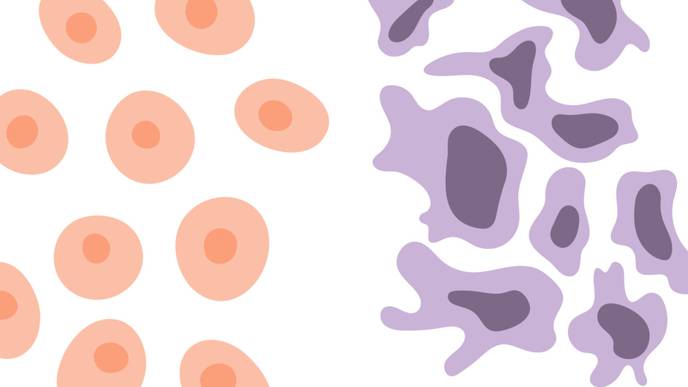ReachMD
Be part of the knowledge.™Researchers Develop Innovative Technique for Distinguishing Tumor from Normal Tissue

Mass General Brigham brings together 16 member institutions, including academic medical centers, top-tier specialty hospitals, community hospitals, a rehabilitation network and more. Research that spans more than one of these entities is more than the sum of its parts, helping to provide insights and unique perspectives from multiple settings and areas of expertise.
Many technologies have been pursued to improve visualization of tumors during surgery, including fluorescence imaging and advanced microscopy, but such technologies have not yet been widely adopted and most are restricted to specific types or subtypes of cancer. Fluorescence imaging can use dyes to target cancer-specific molecules, but standard imaging techniques can have limited accuracy for detecting tumor margins—or the edges of normal tissue that surround a tumor—since the expression of these molecules can vary widely within and across tumor types.
The technique used by the Mass General Brigham team, known as FLT imaging, takes a different tact. Instead of relying on dyes only for targeting cancer, the technique uses high-speed cameras to detect changes in the property of the light emitted by tissue. In previous studies in preclinical models, Kumar and colleagues found that tumors in mice injected with a dye known as indocyanine green (ICG) had a longer fluorescence lifetime compared to normal tissue. This difference allowed the researchers to accurately distinguish between tumor tissue and normal tissue.
In their current study, the team applied the same principle to samples from patients. The team began by analyzing samples from patients undergoing liver surgery at MGH and head and neck surgery at Mass Eye and Ear. Patients had received an ICG injection at least a day before the surgery.
Building on this initial work, the team collaborated across multiple institutions and evaluated specimens from more than 60 patients representing multiple cancer types, including liver, brain, tongue, skin, bone and soft tissue, who were treated at MGH, Mass Eye and Ear, The University of Pennsylvania, University of Newcastle in the UK, and Leiden University in the Netherlands.
The team was able to detect an FLT shift at the cellular level that was consistent across tumor types and in multiple patients. The technique was also able to distinguish benign from metastatic lymph nodes. Overall, it was more than 97 percent accurate at distinguishing tumor tissue from healthy tissue.
The authors note that although ICG is approved by the Food and Drug Administration for other indications, it is not yet approved for clinical use as a tumor marking agent. The researchers’ next step is to perform a larger scale clinical trial to test the safety and efficacy of fluorescence lifetime imaging with ICG for tumor identification during surgeries.
“Our work suggests that the combination of fluorescence lifetime imaging with ICG could improve surgical resections, thereby impacting patient lives,” said Kumar. “We’re excited to take these next steps to move our discoveries closer to clinical impact.”
Authorship: Mass General Brigham co-authors include Rahul Pal (MGH), Murali Krishnamoorthy (MGH), Hannah R. Collins (MGH), Shriya Shukla (MGH), Amy L. Kendall, Michael S. Marshal (MGH), Stefan A. Carp (MGH), Yin P. Hung (MGH), Angela R. Shih (MGH), Maria Martinez-Lage (MGH), Lawrence Zukerberg (MGH), Peter M. Sadow (MGH and Mass Eye and Ear), William C. Faquin (MGH and Mass Eye and Ear), Brian V. Nahed (MGH), Allen L. Feng (Mass Eye and Ear), Kevin S. Emerick (Mass Eye and Ear), Santiago Lozano-Calderon (MGH), Mark A. Varvares (Mass Eye and Ear), and Kenneth K. Tanabe (MGH). Additional co-authors include Thinzar M. Lwin, Corey D. Chan, Andrey Prilutskiy, MacLean P. Nasrallah, Tom H. Dijkhuis, J Sven D Mieog, Alexander L. Vahrmeijer, Karthik Rajasekaran, John Y. K. Lee, and Kenneth S. Rankin.
Disclosures: Kumar, Krishnamoorthy and Pal are co-inventors of a pending U.S. Patent application issued to The General Hospital Corporation. The patent might be the subject of a licensing agreement in the future. Hung received royalties from Elsevier publishing company unrelated to this study. Rankin received remuneration for lecturing on a Stryker Fluorescence Guided Surgery Conference.
Funding: This work was supported in part by the National Institutes of Health (R01-CA211084, R01-CA260857, 1P01CA240239) and the MGH-Executive Committee on Research Interim Support Fund.
Paper cited: Pal R et al. “Fluorescence lifetime of injected indocyanine green as a universal marker of solid tumours in patients” Nature Biomedical Engineering DOI: 10.1038/s41551-023-01105-2
Facebook Comments